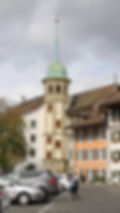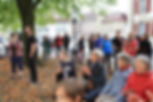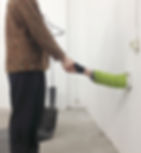slideshow & video
Impressions during exhibition in Kunsthaus and the bell tower, 2017
Video teaser to promote voting, 2017


















public this-play
Intervention. Co-op with Dimitri Fischer
Bell tower with Carillon, melodies, polling booth at Kunsthaus
2017
During the NEOSCOPE exhibition, Fischer / Lippuner´s intervention lead to new and atypic sounds being played on the Carillon (a chime consisting of 25 bells) of the local bell tower. From there, the tunes and jingles were audible on the central square in the old town, located nearby Kunsthaus Zofingen. The work questions the effect and decision-making behind the melodies that are played in public.
The proposed sounds represent a colorful mixture of "modernized" alternatives to religious and march songs, most notably ring and alarm tunes known from mobile devices. Further, the library contains soundtracks of movies and video games, jingles, as well as hip-hop and rock tracks. The visitors of the exhibition were able to listen to the original songs at Kunsthaus, where they where asked about their favourite piece and submit their vote. For the duration of two months, the Top-3 of the respective votes at Kunsthaus were played live on the bell tower, every Saturday.
In that way, the work broke both with the tradition of perceiving art, as well as the staging of concerts. The sounds meandered through the alleys of the village, being perceived by surprised passengers walking by. Attendants of the museum could not directly hear what their vote will do. This separation between voters and listeners / receivers was a deliberate decision, as the artists want to point at this dichotomy. The Kunsthaus remained institution, a place of administration and discussion, directing the waves of how art is transmitted.


images & video
Installation views at exhibition LIE TO ME at Improper Walls, 2019
liquid noise
Interactive installation. Co-op with Sarah Glück
Toilet, directional microphones, speaker
2019
Get a bevy, pour-it-in, chit-chat, drip drop, bladder pop. The location to happen for the best is the room for rest.
Hush, no rush, dont forget to flush. Clean fingers, fingers clean, before and after.
Be prepared this is a way of communication.
Soothing to know about every body, the ease with how fluids pass, just like secrets do.
At first, visitors of the location are not directly informed about the fact that microphones are being installed in the toilet (...) Some activities and collateral noises are audible, their sounds are transmitted to a speaker placed inside the gallery's ventilation system.
From there, people in front of the space, visitors as well as passengers, can listen to them. As the restroom is located in the back, the unaware "actors" were not directly visible and remained anonymous - unless they actually want to reveal themselves. Over the course of an evening, people start to realise from where these familiar but strange noises derive. From then on, the stage was open.
The work is an invitation to discover, perform and interact with each other by encouraging the audience to lose the fear of their most private noises, as well as thoughts.
SIE ( )
Installation. Co-op with Daniela P. Meier
Ceiling, adhesive tape. Dimensions according to space
2015
The taped lines on the ceiling match the interior from the room above the art space - a sketch of a private space inhabited by a student.
Together with the brilliant Daniela P. Meier, the work was developped on-site at ruelle contemporary art space in Mainz, for the upcoming group show centred around passing borders.
slideshow
Installation views during überschreiten exhibition at ruelle contemporary, 2015





Corpus Kon-tiki 1 (wir machen Kohle)

Corpus Kon-tiki 1 (wir machen Kohle)


Corpus Kon-tiki 1 (wir machen Kohle)
corpus kon-tiki
Series of interventions. Co-op with Christian Fischer
Charcoal burner, organic materials, wood, display
2019
By contextualizing the transformation of matter as cycles of value and cultural purpose, this series of interventions follows a simple goal: To share ideas and knowledge by involving the people in the process.
Organic matter has, aside from its nutritional potential as food, also some potential as energy (f.e. bio-waste), agricultural potential (as activated carbon, for soil) and cultural potential (for rituals, spanning from occultism to art). These relations are put into question several times within the intervention.
Summary from the project´s debut at HSG
In 2015, a jury summoned by ProArte selected this project to intervene at the HSG (University of St. Gallen), one of Europe‘s leading schools of economy. On-site, Christian and Rafael performed an entire synthesis of art within the span of one busy week: From collecting resources to inspiration, the process of selection and transforming the materials to finally install and (re-)present the new objects in an exhibition setup.
A lunch break unlike any other at the canteen: Two new members of the economic crop walk around, looking for food. They sit down and explain their vision to the students, briefing them about the options they have with their food: Digest, donate, or throw away to a biogas-refinery. Of course, hunger always prevails, but leftovers could be greenwashed or speculated with to go for hardcore money.
Who invested in art was about to witness the transformation of her / his "sacrifice" by the cozy fire in the Kon-tiki oven (a type of charcoal stack, named after the south american deity). The shape of this burner prevents gas from retracing, allowing the wood to carbonize without turning into ember. Beforehand, the organic material was inventoried, then put into special boxes so it won‘t lose its shape during carbonisation in the oven.
Eventually, the coal-objects were shown in a exhibition at the atrium of the HSG, proclaimed to be pieces of art, all under the curious eyes of the economy students.
slideshow
Impressions from the intervention at HSG and others
video
Cat Research Society: A Day-Night Cycle in the Life of Kotor´s Kitten
Video 9:40 min
2019
Cat Research Society
Intervention. Co-op with Sarah Glück
Guided tour, Duration 30 min
2019
The Cat Research Society aims for a deeper understanding of the personal relations and symbiotic bonds forming between human and cats. Let´s stray together!
Starting in Kotor (Cattaro), the self-proclaimed “city of cats“ of Montenegro, the artist duo followed and hang around with the local cats in an attempt to perceive the city from their perspective. The way in which an individual understands its surroundings and interacts with it has reciprocal effects. As the biologist Jacob von Uexküll put it (»Umwelt und Innenwelt der Tiere«, 1909), every organism cuts its specific environment out of the world, according to its needs and its perceptual equipment. Things change their meaning in relation to the subject. This relationship transforms an object into a carrier of meaning that is imprinted on it by the subject, and it is the assemblage of meanings that shapes the environment of every individual. The meaning attributed to one and the same object changes depending on the subject perceiving it and its momentary condition. In a nutshell: The Umwelt of an animal is mirrored in its inner world. *
In the case of Kotor, the structure of the city with its narrow alleys and wide squares, its mediterranean architecture are mirrored in the inner worlds of its inhabitants. The old town, labeled UNESCO cultural and natural heritage, attracts floods of tourists on a daily basis, a reputation that impacts the working and living conditions of all locals – human or cat.
By observing how citizens, tourists, shop owners and restaurant staff interact with "their“ cats, CRS is looking for new kinships in culture as part of a larger interest in human-animal-relations. This concern extends to artistic and philosophic topics and is inspired by the views of Donna Haraway (»When species meet« 2007) and Vinciane Despret (»The body we care for. Figures of anthropo-zoo-genesis« 2004). Both scientist's work discusses the need to redefine the relation between humans and animals and develop new practices of “humaniamility“, of living and dying together: "What practices of politeness between animals and humans are desirable? How do they produce knowledge together, e.g. in ethology? How do animals work for humans? What does that mean for concepts of agency? How political are such questions in relation to recent cosmopolitical, ecological constellations?" **
* Busch, Margit; C.A.T.s in Uexküllian bubbles. In: Catastrophic Animals on Terra – A guidebook to life elsewhere (Vienna, 2019), Universität für angewandte Kunst Wien, p. 22-23
** V.Despret; D.Haraway; K.Harrasser; K.Solhdju: Stay where the trouble is. In: Zeitschrift für Medienwissenschaft. Jg. 3, Heft 04, Menschen & Andere (Bielefeld, 2011), DOI: https://mediarep.org/handle/doc/2703, transcript Verlag Bielefeld

Brun, die sich ins Grüne münden


Brun in construction and under the influence

Brun, die sich ins Grüne münden
Kollektiv Brun + Brun
Intervention. Co-op with Valentin Beck et al.
Construction trailer, chalk, wood, cooking stove
On HSLU campus, duration 1 week
2013
Spontaneous performances, talks, chalk, cooking, discussing art and design and the everlasting question how to live with all of this. Kollektiv Brun + Brun, or the program is the question. We invited all students of the campus at HSLU Design & Kunst in Lucerne to join our trailer as a vessel for experimentation, collectively.
Slides show impressions and ramifications of Brun + Brun´s presence at the campus.


